|
|
Drawings on the wall of Abbey Knockmoy, Co. Galway, Ireland, 15th Century.
Extract from pp.42-44, Eighty-first annual report of the Commissioners of Public Works in Ireland, with appendices. 1912-1913
APPENDIX E
ABBEY KNOCKMOY, Co. GALWAY.
Repairs. Mural Paintinqs.
A large overgrowth of ivy was removed from the walls of the nave, the vaulted. roofs of the chancel and side chapels were staunched where leaking, and a general clearing up of the church was effected, including the removal of a portion of the debris from the north side chapels and at the entrance to the chapter house. A large portion of the chancel, transepts, nave and aisle are covered with debris to the depth of several feet, which will require removal when funds are available. The remaining portion of the cloister garth and the interior of the domestic buildings are used as the local burial place without any attempt at order and not subject to supervision, with the usual unsightly result and danger in attempting to cross amongst the caves and over the stones thrown up in the process of digging for interments.
The drawings on the north wall of the chancel usually described as "frescoes," have now the outlines barely visible, and can only be discerned when there is a strong south light. Some years ago there was a greenish hue caused by damp and vegetation over a portion of the drawings, which gave rise to the belief that they were coloured, but this has disappeared, leaving only the "bare black outlines," as they were described by Gabriel Beranger in 1779. There are two, if not three, divisions in the picture, the upper portion representing the well-known subject "Los Trois Morts et lee Trois Rois Vile." The symbolism of the three living kings in the presence of the three dead kings was a popular legendary morality illustrating the vanity of human greatness. Three kings are confronted by three skeletons, who admonish them that as they too were once kings ere long will the kings be such as they.
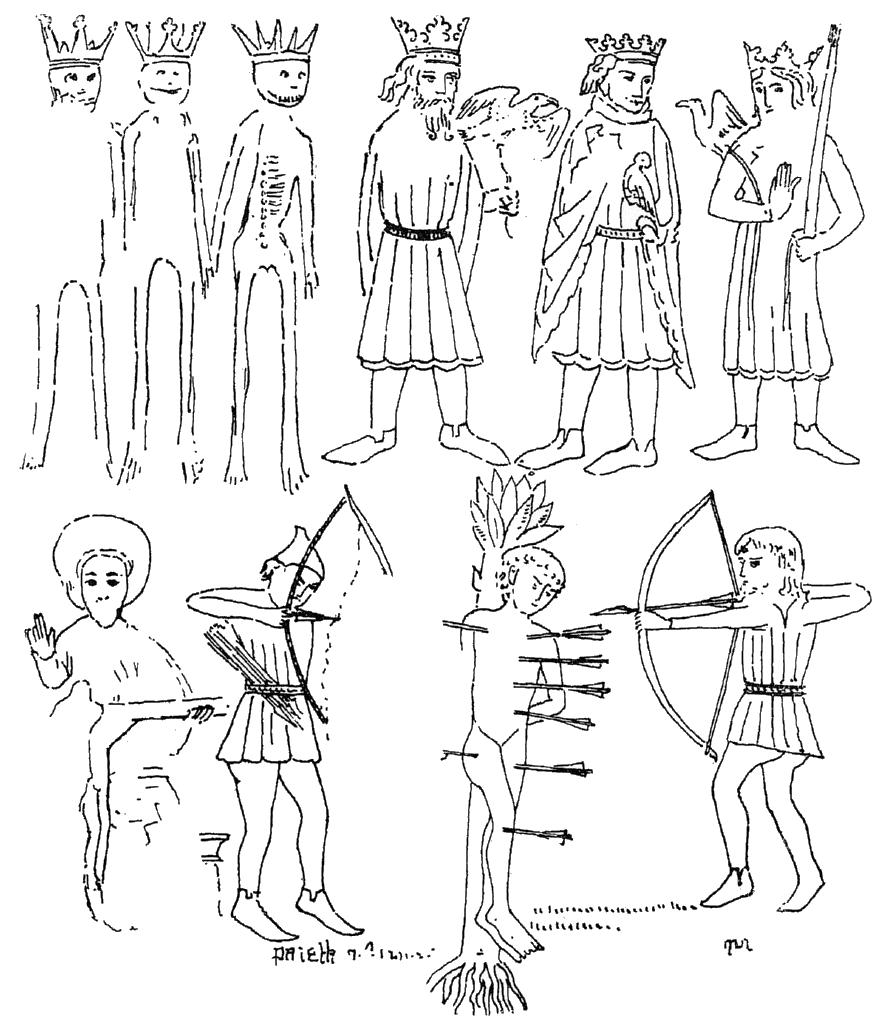
Fig. 3. SKETCH OF WALL PAINTING IN THE CHANCEL OF ABBEY KNOCKMOY.
Below this there is a representation of what is commonly called The Martyrdom of St. Sebastian" ; the saint is shown as a nude figure attached to a tree, and there are two archers, one at each side discharging their arrows into his body.
It is highly probable that this is intended as a representation of the martyrdom of St. Christopher and not of St. Sebastian. The legend of the former saint was very popular, and there are numerous examples in churches in England, which at a calculation would amount to about 180, where the pictures of St. Sebastian are only about 20 in number. One of the best representations of St. Christopher is in the mural painting in the church of Shorwell, Isle of Wight, and is the most interesting yet brought to light. Besides his conversion and crossing the stream with the Infant, his martyrdom is depicted in much the same way as in the thawing at Abbey Knockmoy. There are two archers, one on each side of the saint, who is bound to the tree, his body pierced with arrows. There can be no doubt as to the identity of St. Christopher in the Shorwell painting, and as the Knocknoy representation is similar the natural inference is that it is St. Christopher that is represented there also. There is a sculptured figure of this saint in the panel of a pair of coupled columns of the cloister arcade in Jerpoint Abbey, County Kilkenny.
The third subject is clearly a fragment of the representation of the Trinity so often reproduced in churches in the 16th century. There was a special order of the Commonwealth to destroy all these existing examples, and but few survived that period. It was usual to delineate the First Person as a man seated with the Second Person on the cross between his knees, and the Third Person was introduced in the form of a dove or star. The latter is not now visible on the Knockmoy drawings, and only a portion of the cross can be made out.
Click for a photograph of the mural painting.
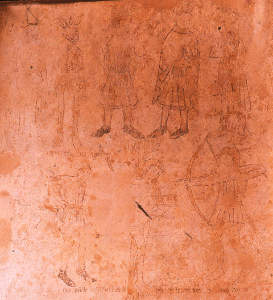
An 18th century artist's impression of the fresco in Knockmoy Abbey, Galway
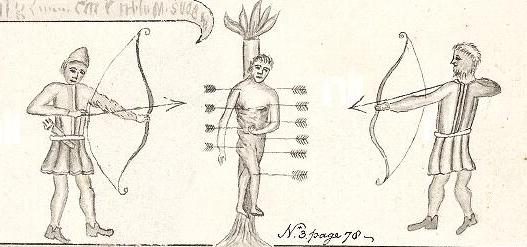
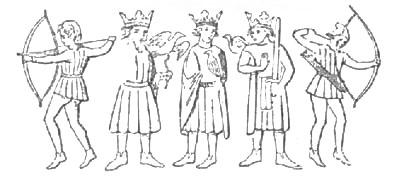
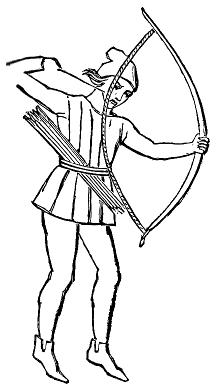
The archer is depicted in a very short houppelande with a plain, round neckline, fitted sleeves and belt at waist He also wears hose, a phrygian cap and laced boots.
For more information see an extract from
Abbey Knockmoy, Co. Galway-Notes on the building and 'frescoes' by Robert Cochrane, August 9, 1904
and an extract from
The Journal of the Royal Society of Antiquaries of Ireland, Fifth Series, Vol. 15, pp. 419-21, 1905
|





